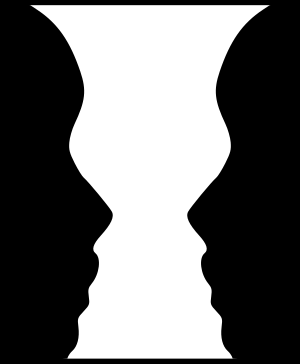
Source: Wikipedia
For this challenge, you should write two programs which resemble the figure and ground of the above image, such that one of them prints figure and the other prints ground. Specifically:
- Write a program which takes no input and prints the string
figure. The only allowed whitespace characters in your program are spaces (code point 0x20) and newlines (carriage returns, 0x0D, linefeeds, 0x0A, or a combination of both). Ignoring the newlines, the number of space characters (code point 0x20) and non-space characters has to be the same. For example, this would be a valid program (in a hypothetical language):
ab c d e fNote that there is a trailing space on the first line.
If you swap the nth space character with the nth non-whitespace character, the program should print
groundinstead. For the above example the program would look like this:a b cde fNote that there are trailing spaces on the second and third lines.
Both the figure and the ground solutions should be full programs in the same language which print to STDOUT. You may print a single optional trailing newline in either case. You may output anything you want to STDERR, as long as STDOUT is correct.
You may use any programming language, but note that these loopholes are forbidden by default.
This is code-golf, so the shortest valid answer – measured in bytes – wins.
Helper Script
You can use this CJam script to convert between a figure and ground program. Simply paste one of the two into the Input field and run the program. It will also tell you if there the number of spaces and non-spaces doesn't match up.
Leaderboard
function answersUrl(a){return"http://api.stackexchange.com/2.2/questions/"+QUESTION_ID+"/answers?page="+a+"&pagesize=100&order=desc&sort=creation&site=codegolf&filter="+ANSWER_FILTER}function commentUrl(a,b){return"http://api.stackexchange.com/2.2/answers/"+b.join(";")+"/comments?page="+a+"&pagesize=100&order=desc&sort=creation&site=codegolf&filter="+COMMENT_FILTER}function getAnswers(){jQuery.ajax({url:answersUrl(answer_page++),method:"get",dataType:"jsonp",crossDomain:!0,success:function(a){answers.push.apply(answers,a.items),answers_hash=[],answer_ids=[],a.items.forEach(function(a){a.comments=[];var b=+a.share_link.match(/\d+/);answer_ids.push(b),answers_hash[b]=a}),a.has_more||(more_answers=!1),comment_page=1,getComments()}})}function getComments(){jQuery.ajax({url:commentUrl(comment_page++,answer_ids),method:"get",dataType:"jsonp",crossDomain:!0,success:function(a){a.items.forEach(function(a){a.owner.user_id===OVERRIDE_USER&&answers_hash[a.post_id].comments.push(a)}),a.has_more?getComments():more_answers?getAnswers():process()}})}function getAuthorName(a){return a.owner.display_name}function process(){var a=[];answers.forEach(function(b){var c=b.body;b.comments.forEach(function(a){OVERRIDE_REG.test(a.body)&&(c="<h1>"+a.body.replace(OVERRIDE_REG,"")+"</h1>")});var d=c.match(SCORE_REG);d?a.push({user:getAuthorName(b),size:+d[2],language:d[1],link:b.share_link}):console.log(c)}),a.sort(function(a,b){var c=a.size,d=b.size;return c-d});var b={},c=1,d=null,e=1;a.forEach(function(a){a.size!=d&&(e=c),d=a.size,++c;var f=jQuery("#answer-template").html();f=f.replace("{{PLACE}}",e+".").replace("{{NAME}}",a.user).replace("{{LANGUAGE}}",a.language).replace("{{SIZE}}",a.size).replace("{{LINK}}",a.link),f=jQuery(f),jQuery("#answers").append(f);var g=a.language;g=jQuery("<a>"+g+"</a>").text(),b[g]=b[g]||{lang:a.language,lang_raw:g,user:a.user,size:a.size,link:a.link}});var f=[];for(var g in b)b.hasOwnProperty(g)&&f.push(b[g]);f.sort(function(a,b){return a.lang_raw.toLowerCase()>b.lang_raw.toLowerCase()?1:a.lang_raw.toLowerCase()<b.lang_raw.toLowerCase()?-1:0});for(var h=0;h<f.length;++h){var i=jQuery("#language-template").html(),g=f[h];i=i.replace("{{LANGUAGE}}",g.lang).replace("{{NAME}}",g.user).replace("{{SIZE}}",g.size).replace("{{LINK}}",g.link),i=jQuery(i),jQuery("#languages").append(i)}}var QUESTION_ID=101275,ANSWER_FILTER="!t)IWYnsLAZle2tQ3KqrVveCRJfxcRLe",COMMENT_FILTER="!)Q2B_A2kjfAiU78X(md6BoYk",OVERRIDE_USER=8478,answers=[],answers_hash,answer_ids,answer_page=1,more_answers=!0,comment_page;getAnswers();var SCORE_REG=/<h\d>\s*([^\n,<]*(?:<(?:[^\n>]*>[^\n<]*<\/[^\n>]*>)[^\n,<]*)*),.*?(\d+)(?=[^\n\d<>]*(?:<(?:s>[^\n<>]*<\/s>|[^\n<>]+>)[^\n\d<>]*)*<\/h\d>)/,OVERRIDE_REG=/^Override\s*header:\s*/i;body{text-align:left!important}#answer-list,#language-list{padding:10px;width:350px;float:left}table thead{font-weight:700}table td{padding:5px}<script src="https://ajax.googleapis.com/ajax/libs/jquery/2.1.1/jquery.min.js"></script><link rel="stylesheet" type="text/css" href="//cdn.sstatic.net/codegolf/all.css?v=83c949450c8b"><div id="language-list"> <h2>Shortest Solution by Language</h2> <table class="language-list"> <thead> <tr><td>Language</td><td>User</td><td>Score</td></tr></thead> <tbody id="languages"> </tbody> </table></div><div id="answer-list"> <h2>Leaderboard</h2> <table class="answer-list"> <thead> <tr><td></td><td>Author</td><td>Language</td><td>Size</td></tr></thead> <tbody id="answers"> </tbody> </table></div><table style="display: none"> <tbody id="answer-template"> <tr><td>{{PLACE}}</td><td>{{NAME}}</td><td>{{LANGUAGE}}</td><td>{{SIZE}}</td><td><a href="{{LINK}}">Link</a></td></tr></tbody></table><table style="display: none"> <tbody id="language-template"> <tr><td>{{LANGUAGE}}</td><td>{{NAME}}</td><td>{{SIZE}}</td><td><a href="{{LINK}}">Link</a></td></tr></tbody></table>